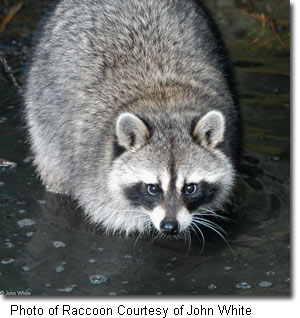Raccoon
(Procyon lotor)
 Description:
Description:
Raccoons are stocky mammals that have short front legs and long
back legs. Raccoons have a striped tail with a black “mask” on their face. They have grayish-black fur and rounded ears. Males are known as boars and females are known as sows. Adult raccoons generally measure 20-30 inches long from their nose to the tip of their tail and weigh from 10-35 lbs.
Range:
Raccoons are abundant throughout Maryland and the rest of the
United States.
Habitat
Raccoons can be found in riparian areas along streams, lakes,
marshes, swamps, farmland, and in suburban neighborhoods. They also can be found
in urban areas where they can find adequate food water, and shelter.
Behavior:
Raccoons generally are solitary, though some related females
will share similar territories. Raccoons typically den in hollow trees, ground
burrows or brush piles but will use barns, attics or an abandoned buildings.
Raccoons are most active from Spring until Fall in Maryland. However, sometimes
they will emerge from their dens during the winter to feed. Raccoons are
considered nocturnal but will forage during the day when conditions allow.
 Diet:
Diet:
Raccoons are omnivores, meaning that they eat both plants and
animals. Raccoons relish plums, gooseberries, blackberries, blueberries, dogwood
berries, wild cherries, currants, wild grapes, apples and hawthorns. They also
find acorns, hazelnuts and beechnuts appealing when in season. Raccoons also eat
crayfish, fish, turtle eggs, snails and clams. Interestingly enough, raccoons
have well developed sensory nerves on the bottom of their feet. Raccoons will
feel their food items with their paws and will remove unwanted parts.
Reproduction:
Raccoons breed from the end of January through mid-March.
After a gestation of 65 days, raccoons will give birth to 2-5 young known as
kits. Kits will remain with the female until Fall. Males take no part in raising
young.
Raccoons & People:
Raccoons can be nuisance wildlife. Raccoons are well adapted to
urban and suburban areas and can easily get into houses, basements and attics.
In addition, raccoons often raid trash cans and pet food left outside. Raccoons
furthermore are responsible for 60% of the rabies cases in Maryland and can also
transmit canine distemper and parvovirus to domestic dogs.
MD DNR has contracted with the USDA Wildlife Services to
establish a public access nuisance animal hotline. Wildlife Service specialists
are available to provide technical guidance or facilitate contacts with
professional Nuisance Wildlife Cooperators. Individuals that are experiencing
problems with raccoons or other wildlife species are encouraged to call (877)
463-6497. You can also find tips on how to avoid nuisance raccoons in your
backyard on the Wild Acres website.
Did You Know?
The scientific name for the raccoon is Procyon lotor and in
Latin, lotor means "one who washes". Raccoons are known for their habit of "washing" their food in water. Wildlife biologists believe that raccoons have very sensitive fingers and as they forage for food in water (crayfish, tadpoles, frogs, etc.), they actually feel what they are doing rather than see what they are about to eat. Raccoons are known for their intelligence, and studies have
shown that raccoons can remember how to solve tasks for up to three years.
Click here to learn
more information about wildlife management of the species.
Raccoon profile picture courtesy of John White
Raccoon in tree picture courtesy of the US Fish and Wildlife Service